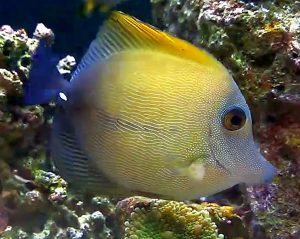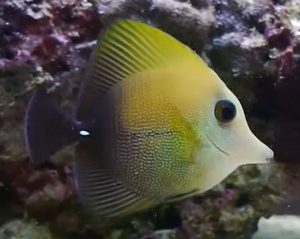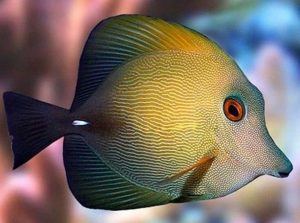Scopas Tang (Zebrasoma scopas) known to tropical fish keeping enthusiasts as the Brush Tail Tang, Two Tone Tang, or Brown Tang is found throughout the Indo Pacific and ranges from the coasts of East Africa to Japan, the Pitcairn Islands, Malaysia, Indonesia, Japan, Australia, Lord Howe Island and Rapa Iti. Although several Brown Tangs were observed far outside their range near Fort Lauderdale, Florida, they were no doubt released aquarium specimens.
Adult Scopas Tangs are quite gregarious and can be found in pairs, singly, or in large schools on the exposed side of reefs in the coral rich lagoons of their range at depths to 200 feet. Juvenile Scopas Tangs are much more solitary and prefer shallower waters where they swim among the corals grazing on filamentous algae, detritus, and small invertebrates.
The Scopas Tang has a deep, laterally compressed body with a protruding snout and specialized pharyngeal teeth that they use for feeding on filamentous algae. They have a whitish tan colored head and a pale brown colored body that becomes a dark brownish black near the darker, nearly black tail and a white spine on the caudal peduncle. Squiggly pale green to yellow longitudinal lines on the body begin as small dots at the head and continue through the posterior region into dots around the caudle pendacle.
Juvenile Brown Tangs are somewhat paler than adults, have thin yellowish white vertical lines that transverse the body, and have exaggerated dorsal and anal fins.
Scopas Tang coloration is highly variable. Specimens can be solid black or solid yellow and incorporate various shades of gray, brown, yellow, and white in their body coloration. Fiji colored Scopas are mostly yellow, dorsally, and brown, ventrally.
Adult males are generally larger than females.
The Scopas Tang is reef safe and can be housed in either a mature FOWLR or reef aquarium of at least 125 gallon capacity with a crushed coral or coralline sand substrate, good amounts of live rock arranged into caves, crevices, and overhangs, and plenty of free swimming space. They will not bother corals and will voraciously eat any nuisance algae that inadvertently grows in the tank.
Brown tangs are one of the more peaceful species within its genus that can be kept with other tang species. Other tankmates can include Flame Angelfish (Centropyge loricula), Royal Gramma (Gramma loreto), Firefish Goby (Nemateleotris spp.), Lawnmower Blenny (Salarias spp.), Blue Green Chromis (Chromis viridis), etc.
Although the Scopas Tang is tolerant of a wide range of water parameters; adequate water flow, good filtration, heavy protein skimming, and regular small water changes are recommended to maintain water quality.
The Scopas Tang is occasionally available to hobbyists through aquaculture, however, they have not been bred in an aquarium environment.
Although the Scopas Tang is primarily monogamous, they have been observed spawning in pairs and in small groups. The larger males rush up to the surface to spawn with the smaller females. The externally fertilized eggs are scattered into the water column where the planktonic larvae drift with the current for several weeks before settling to the bottom. The larvae feed on microalgae until their metamorphosis into juveniles.
Where their range overlaps, the Scopas Tang (Zebrasoma scopas) and Black Tang (Zebrasoma rostratum) are known to hybridize. The offspring have less elongated snouts, a bluish body color, slightly more yellow dorsal fins, and eyes that appear more orange.
In their natural habitat, Zebrasoma scopas feed mainly on filamentous algae. In an aquarium environment they will accept a variety of vegetable and meaty foods. In addition to the nuisance hair algae that they may consume in the tank; they should be offered plenty of seaweed, sheets of high quality marine algae, Spirulina, marine herbivore pellets, and occasionally frozen meaty foods like brine and Mysis shrimp.
It is important that plenty of fresh, frozen, or freeze dried marine based seaweed and algae is provided to strengthen their immune systems, reduce aggression, and improve their overall well being.
Dried Nori tied to a rock or clipped in a veggie clip should be presented on a daily basis or at least three times a week. Sea Veggies, Seaweed Salad, and Ocean Nutrition are all ideal products that are convenient to use.
The Scopas Tang (Zebrasoma scopas) is readily available to tropical fish keeping enthusiasts from specialty fish shops and online from wholesalers, retailers, and trans shippers at the following approximate purchase sizes: Small: 1″ to 2″; Small/Medium: 2″ to 3″ Medium: 3″ to 4″; Medium/Large: 4″ to 5″; Large: 5″ to 6″; XLarge: 6″ or Higher.
Prices vary according to size and locale and range from $39.99 for small Indonesian and Philippines specimens to $149.99 for medium Fiji specimens.
Minimum Tank Size: 180 gallons
Aquarium Type: Reef or FOLR
Care Level: Moderate
Temperament: Peaceful to Semi-aggressive
Aquarium Hardiness: Very Hardy
Water Conditions: 74-78° F, dKH 8-12, pH 8.1-8.4, sg 1.020-1.025
Maximum Size: 12″
Color Form: Black, Brown, Yellow
Diet: Omnivore
Compatibility: Reef or FOWLR
Origin: Indo Pacific
Family: Acanthuridae
Lifespan: 7 – 10 years
Aquarist Experience Level: Intermediate




